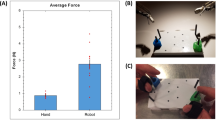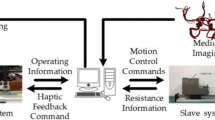Abstract
Providing a surgeon with information regarding contacts made between instruments and tissue during robot-assisted interventions can improve task efficiency and reliability. In this report, different methods for feedback of such information to the surgeon are discussed. It is hypothesized that various methods of contact feedback have the potential to enhance performance in a robot-assisted minimally invasive environment. To verify the hypothesis, novel mechanisms needed for incorporating contact feedback were designed, including a surgeon–robot interface with full force feedback capabilities and a surgical end-effector with full force sensing capabilities, that are suitable for minimally invasive applications. These two mechanisms were used to form a robotic “master–slave” test bed for studying the effect of contact feedback on the system and user performance. Using the master–slave system, experiments for surgical tasks involving soft tissue palpation were conducted. The performance of the master–slave system was validated in terms of criteria that assess the accurate transmission of task-related information to the surgeon, which is critical in the context of soft tissue surgical applications. Moreover, using a set of experiments involving human subjects, the performance of several users in carrying out the task was compared among different methods of contact feedback.






Similar content being viewed by others
Notes
As discussed later, the main reason for this is that any contact made between the da Vinci’s instruments and the patient’s body is estimated from outside the patient rather than through direct measurement from inside.
The relationship between the indenting force/torque and the deformation of biologic tissue, such as liver, is linear for small deformations [7], but tends to become nonlinear (2nd order) for large deformations [20]. As can be seen, the data collected from the silicon-based phantom is in good agreement with a second order stress-strain relationship, implying that it closely approximates real tissue.
References
Ballantyne GH (2002) Robotic surgery, telerobotic surgery, telepresence, and telementoring. Surg Endosc 16: 1389–1402
Breedveld P, Stassen HG, Meijer DW, Jakimowicz JJ (2000) Observation in laparoscopic surgery: overview of impeding effects and supporting aids. J Laparoendosc Adv Surg Tech 10: 231–241
Burdea GC (1996) Force and touch feedback for virtual reality, John Wiley & Sons, New York
Chamberlain Group LLC (2006) Accessed July 2006 at http://www.thecgroup.com
Dario P, Hannaford B, Menciassi A (2003) Smart surgical tools and augmented devices. IEEE Trans Robotics Automation 19: 782–792
Debus T, Jang TJ, Dupont P, Howe R (2004) Multi-channel vibrotactile display for teleoperated assembly. Int J Control Automation Systems 2: 390–397
Fung YC (1993) Biomechanics: mechanical properties of living tissues. 2nd ed. Springer-Verlag, New York
Furukawa T, Morikawa Y, Ozawa S, Wakabayashi G, Kitajima M (2001) The revolution of computer-aided surgery: the dawn of robotic surgery. Minim Invasive Ther Allied Technol 10: 283–288
Gerovichev O, Marayong P, Okamura AM (2002) The effect of visual and haptic feedback on manual and teleoperated needle insertion. In: Dohi T, Kikinis R (eds) Proceedings of the 5th International Conference on Medical Image Computing and Computer Assisted Intervention (MICCAI): Lecture Notes in Computer Science. Springer, Tokyo, Japan. Vol. 2488, pp, 147–154
Hannaford B, Wood L (1989) Performance evaluation of a 6 axis high fidelity generalized force reflecting teleoperator. In: Proceedings of JPL/NASA Conference on Space Telerobotics, Pasadena, CA, pp 89–97
Hashizume M, Shimada M, Tomikawa M, Ikeda Y, Takahashi I, Abe R, Koga F, Gotoh N, Konishi K, Maehara S, Sugimachi K (2002) Early experiences of endoscopic procedures in general surgery assisted by a computer-enhanced surgical system. Surg Endosc 16: 1187–1191
Holden JG, Flach JM, Donchin Y (1999) Perceptual-motor coordination in an endoscopic surgery simulation. Surg Endosc 13: 127–132
Howe RD, Matsuoka Y (1999) Robotics for surgery. Annu Rev Biomed Eng 1: 211–240
Jourdan IC, Dutson E, Garcia A, Vleugels T, Leroy J, Mutter D, Marescaux J (2004) Stereoscopic vision provides a significant advantage for precision robotic laparoscopy. Br J Surg 91: 879–885
Kitagawa M, Dokko D, Okamura AM, Yuh DD (2005) Effect of sensory substitution on suture manipulation forces for robotic surgical systems. J Thorac Cardiovasc Surg 129: 151–158
Lazeroms M (1999) Force reflection for telemanipulation applied to minimally invasive surgery. Ph.D. thesis. Delft University of Technology, The Netherlands
Lum MJH, Rosen J, Sinanan MN, Hannaford B (2004) Kinematic optimization of a spherical mechanism for a minimally invasive surgical robot. In: Proceedings of IEEE International Conference on Robotics and Automation, New Orleans, LA, pp 829–834
Madhani AJ, Niemeyer G, Salisbury JK Jr (1998) The Black Falcon: a teleoperated surgical instrument for minimally invasive surgery. In: Proceedings of IEEE/RSJ International Conference on Intelligent Robots and Systems, Victoria, BC, Canada
Massimino MJ (1992) Sensory substitution for force feedback in teleoperation. Ph.D. thesis. MIT, Cambridge, MA
Okamura AM, Simone C, O’Leary MD (2004) Force modeling for needle insertion into soft tissue. IEEE Trans Biomed Eng 51: 1707–1716
Picod G, Jambon AC, Vinatier D, Dubois P (2005) What can the operator actually feel when performing a laparoscopy? Surg Endosc 19: 95–100
Ruurda JP, Wisselink W, Cuesta MA, Verhagen HJ, Broeders IA (2004) Robot-assisted versus standard videoscopic aortic replacement: a comparative study in pigs. Eur J Vasc Endovasc Surg 27: 501–506
Sherman A, Cavusoglu MC, Tendick F (2000) Comparison of teleoperator control architectures for palpation task. In: Nair SS (ed) Proceedings of ASME Dynamic Systems and Control Division. ASME, Orlando, FL. Vol. DSC 69-2, pp 1261–1268
Shimoga KB (1993) A survey of perceptual feedback issues in dextrous telemanipulation: Part I. Finger force feedback. In: Proceedings of IEEE Annual Virtual Reality International Symposium, Seattle, WA, pp 263–270
Sung GT, Gill IS (2001) Robotic laparoscopic surgery: a comparison of the da Vinci and Zeus systems. Urology 58: 893–898
Tavakoli M, Patel RV, Moallem M (2005) Haptic interaction in robot-assisted endoscopic surgery: a sensorized end-effector. Int J Med Robotics Comput Assist Surg 1: 53–63
Tavakoli M, Patel RV, Moallem M (2006) A haptic interface for computer-integrated endoscopic surgery and training. Virtual Reality 9: 160–176
Taylor RM II, Hudson TC, Seeger A, Weber H, Juliano J, Helser AT (2001) VRPN: a device-independent, network-transparent VR peripheral system. In: Proceedings of ACM Symposium on Virtual Reality Software & Technology, Banff, Alberta, Canada, pp 55–61
Taylor RH, Stoianovici D (2003) Medical robotics in computer-integrated surgery. IEEE Trans Robotics Automation 19: 765–781
Tendick F, Jennings R, Tharp G, Stark L (1993) Sensing and manipulation problems in endoscopic surgery: experiment, analysis, and observation. Presence Teleoperators Virtual Environ 2: 66–81
Tendick F, Jennings R, Tharp G, Stark L (1996) Perception and manipulation problems in endoscopic surgery. In: Taylor RH, Lavellee S, Burdea GC, Mosges R (eds) Computer-integrated surgery: technology and clinical applications, MIT Press, Cambridge, Massachusetts pp 567–576
Wagner CR, Stylopoulos N, Howe R (2002) The role of force feedback in surgery: analysis of blunt dissection. In: Proceedings of the 10th Symposium on Haptic Interfaces for Virtual Environment and Teleoperator Systems, Orlando, FL, pp 68–74
Yokokohji Y, Yoshikawa T (1994) Bilateral control of master–slave manipulators for ideal kinesthetic coupling: formulation and experiment. IEEE Trans Robotics Automation 10: 605–620
Acknowledgments
This research was supported by the Ontario Research and Development Challenge Fund under grant 00-May-0709, infrastructure grants from the Canada Foundation for Innovation awarded to the London Health Sciences Centre (CSTAR) and the University of Western Ontario, the Natural Sciences and Engineering Research Council (NSERC) of Canada under grants RGPIN-1345 and RGPIN-227612, and the Institute for Robotics and Intelligent Systems under a CSA-IRIS grant.
Author information
Authors and Affiliations
Corresponding author
Rights and permissions
About this article
Cite this article
Tavakoli, M., Aziminejad, A., Patel, R.V. et al. Methods and mechanisms for contact feedback in a robot-assisted minimally invasive environment. Surg Endosc 20, 1570–1579 (2006). https://doi.org/10.1007/s00464-005-0582-y
Received:
Accepted:
Published:
Issue Date:
DOI: https://doi.org/10.1007/s00464-005-0582-y




